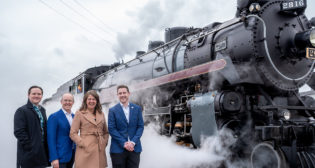
Mexico derailment claims migrant worker lives
Written by William C. Vantuono, Editor-in-ChiefAmbulances were unable to reach the accident scene because of the difficult terrain; rescue workers and soldiers had to be brought in by boat and aircraft. Images from the scene showed overturned freight cars, with trucks separated from their bolsters. Officials said eight of the 12 cars overturned; rescue workers fear more people may still be trapped beneath the cars. Unknown is exactly how many migrants may have been on top of the cars or clinging to its sides at the time of the accident. Local residents said they had seen some 200 people climb aboard at a nearby stop.
 Local officials have blamed the derailment on missing spikes and tie plates. Public Security Minister for Tabasco state Audomaro Martinez Zapata said thieves had “ransacked” the tracks of these components. Heavy rain had washed away some of the underlying soil, causing the tracks to shift, Ferrosur track workers said. Tabasco State Governor Arturo Nunez said the train’s heavy load of scrap metal also may have caused the tracks to sink in the wet ground. Heavy lifting equipment has been sent to the area to move the overturned cars.
Local officials have blamed the derailment on missing spikes and tie plates. Public Security Minister for Tabasco state Audomaro Martinez Zapata said thieves had “ransacked” the tracks of these components. Heavy rain had washed away some of the underlying soil, causing the tracks to shift, Ferrosur track workers said. Tabasco State Governor Arturo Nunez said the train’s heavy load of scrap metal also may have caused the tracks to sink in the wet ground. Heavy lifting equipment has been sent to the area to move the overturned cars.
Tens of thousands of migrants, mostly Central Americans, annually jump aboard La Bestia under cover of darkness. Hundreds die or lose limbs each year as they fall off the train and get caught under its wheels. These incidents, and the August 25 derailment, however, may pale in comparison to the dangers migrant workers face if they manage to reach Mexico City. According to Paul Imison of Britain-based publication The Independent’s Mexico City bureau, migrants in search of a new life are falling into the clutches of Mexican drug gangs:
“Every day, as many as 1,500 migrants alight from the notorious freight train known as La Bestia as it terminates on the outskirts of Mexico City. As if the journey wasn’t dangerous enough, members of Mexico’s most powerful and violent criminal gangs lie in wait as the migrants then traverse on foot the 12-mile route between the railway and a shelter for undocumented migrants in Huehuetoca.
“‘[The gangs] wait as people get off the train,’ says Jorgé Andrade, who worked at the San José migrant shelter, run by a collective known as Ustedes Somos Nosotros (‘You Are Us’). ‘The people are usually dirty, tired and hungry when they arrive. They’ve often been riding the train for seven or eight days. The criminals make them pay a toll to walk the 12 miles to the shelter. If they don’t pay, they kidnap them, beat them, ask for sexual favors. In the worst case, they’ll be forced to work for the gangs or be killed.’
“The journey on The Beast, which travels daily from Chiapas on the southern border with Guatemala to the outskirts of Mexico City, is just as dangerous as the 12-mile walk that awaits the migrants on their arrival. The train routinely carries hundreds of human beings hoping to avoid immigration checkpoints or encounters with corrupt local police. But gangs have hijacked the route, charging $100 or more for permission to mount the train.
“Threats, attacks and extortion continue en route. The attacks are a vital component of Mexico’s organized crime underworld, and constitute a criminal industry estimated to be worth tens of millions of dollars per year. According to a report by Mexico’s National Human Rights Commission (CNDH), in extortion cases the sums of money demanded ranged from $1,000 to $5,000. More than 90 of the 9,758 victims interviewed by the CNDH between September 2008 and February 2009 said public officials, particularly the police, were involved in their kidnapping.
“The Beast [is] a draining journey that often leaves many maimed or dead.”



